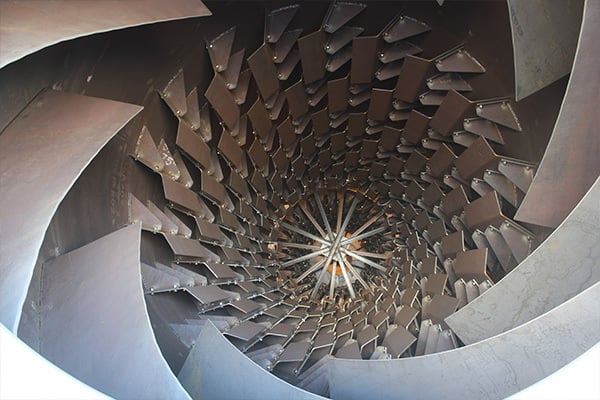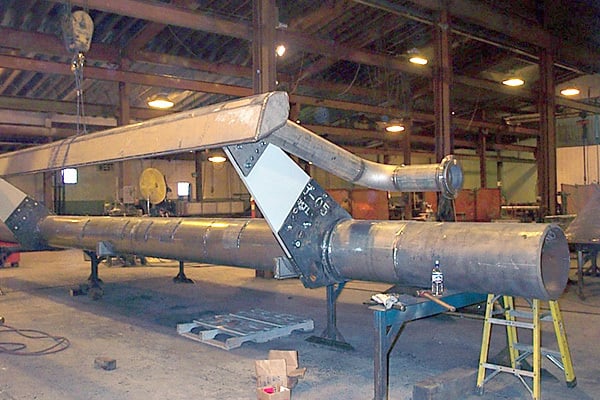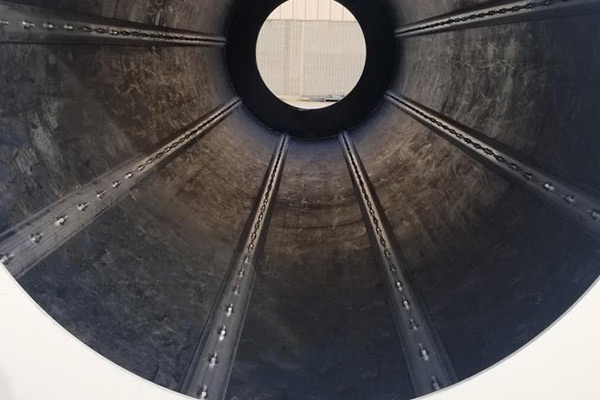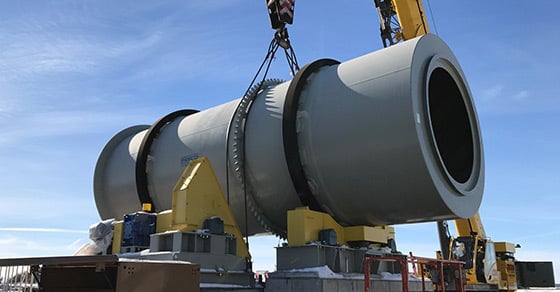Rotary drums are used throughout a number of industries to carry out a range of different objectives, from conditioning to granulation (agglomeration), mixing, and coating. Part of their diverse applicability lies in the ability to customize their internals for a truly optimized processing solution.
In this effort, rotary drum manufacturers have a wide selection of internals at their disposal, each serving a unique function and helping to tailor the drum to its specified application.
Below are some of the most widely employed types of internals used to engineer a rotary drum for optimal performance and efficiency.
Common Rotary Drum Internals
The most common rotary drum internals are:
A Spray System
Spray systems are frequently incorporated into rotary drums as a means of introducing a liquid component to the solid feedstock. Liquids are often utilized and may serve one or multiple roles as a beneficial additive, coating, binder/binding agent, or simply a source of moisture.
Depending on the specific application and process goals, the liquid component may be incorporated into the solid feedstock prior to entering the drum. However, in order to achieve the desired results, it is often necessary to distribute the liquid at different points throughout the drum.
Spray systems are incredibly flexible in design and are typically a very customized aspect of the drum. Options include number and location of spray ports, type(s) of nozzles, rate and concentration of spray, and more.
Common applications in which a spray system is employed include:
- For impregnating industrial solids such as catalysts, filter agents, adsorbents, and more
- For including nutrients or beneficial additives when producing fertilizers and soil amendments
- For coating fertilizer products with anti-caking or anti-dusting agents for improved handling qualities
- For incorporating the leaching agent in heap leaching operations
- For distributing a binding agent in the agglomeration or conditioning/dedusting of fines
Spray System Plate
In some cases, a protective plate is incorporated into the drum over the spray system. This truss-like metal plate is often referred to as a “top hat” and serves to shield the spray system from falling material.
A top hat may be incorporated when the material being processed is prone to clumping, as it is more likely to stick to the spray system if not managed.
Flights
Flights are typically associated with rotary drums that utilize heat transfer, such as dryers, coolers, and kilns, but they can also be useful in other types of drums as well. Depending on process goals, flights may be integrated into the drum in one or both of the following configurations:
Agitation/Tumbling Flights
Agitation flights are perhaps the most common type of flight used in non-heated drums and serve simply to ensure that the bed of material is properly agitated and turned. These flights are not designed to lift material, but rather to disrupt any “sliding” of material in the bed in order to achieve uniform rolling and mixing of the material bed, and where applicable, distribution of the liquid component.
Advancing Flights
Advancing flights, often also called spiral flights for their spiral-like appearance, are only incorporated at the inlet portion of the drum. Combined with the rotation of the drum, this long, curved flight moves material away from the inlet. This prevents clogging and backspill and also helps to move material into the active processing zone faster.

Coating Drum interior equipped with a spray system with top hat and agitation/tumbling flights

Spiral/Advancing flights can be seen (in the foreground) at the inlet of this rotary drum.
A Note on Flight Design:
As with the spray system, flight design is also a very custom part of the rotary drum’s overall design. The structural design of the flight can be customized, as can the pattern of flights throughout the drum. In many settings, it is beneficial to use a bolt-in flight design to allow for easy modification, giving operators an additional tool to optimize the process, while also allowing maintenance personnel to easily change out worn or damaged flights as needed.
Additional Feed Location
While many drums utilize a single feed location, an additional feed point is sometimes helpful. This is often the case in granulation settings where additional fines must be included more gradually to facilitate proper granule growth.
An additional feed location can be located at any point along the drum and is typically fed with a screw conveyor.
Sparger
A sparger is similar in concept to a spray system, but instead of distributing the liquid component over the bed, the sparger distributes it from within the bed.
Spargers are most commonly used when incorporating a gaseous product; if an overhead spray system were used to distribute the gas, only the top of the material bed would likely be exposed. And without the advantage of granule-to-granule transfer typical of a liquid additive, the gas would not be distributed throughout the bed. Instead, a sparger allows the material to be fully distributed throughout the bed.
In some cases, a sparger may be used with a liquid, such as when incorporating sulfuric acid in the production of monoammonium phosphate (MAP) fertilizers. Liquid ammonia is also often added in fertilizer applications, as it would otherwise “flash off” if not fed directly into the material bed.
Sparger location within the drum has a significant impact on the effectiveness of the system and must be carefully considered during design.
Scraper
While liners have largely replaced the use of scrapers in rotary drums (particularly in the fertilizer industry), scrapers are still used on occasion.
Scrapers are used to remove buildup in the drum. Positioned so as to rotate alongside the drum shell interior, the scraper rides on its axis, removing material buildup as the drum rotates.

Custom rotary drum scraper bar for a FEECO Granulation Drum producing MAP/DAP fertilizers
Rotary Drum Liners
Rotary drum liners are useful for a number of reasons, with several different types available depending on the goal.
Liners generally serve two primary purposes: to protect the shell against corrosion or abrasion, or to prevent material from building up in the drum.
The most common types of liners for rotary drums are stainless steel, ceramic, and rubber. Rubber liners are available in either the “popping” or non-popping design. The popping design flexes as the drum rotates, sloughing off any stuck-on material.

Rubber liner in a rotary drum
The choice between a liner and scraper is often one of preference or historical use.
Dams
Just as they do with water, a dam in a rotary drum causes material to build up behind it, eventually spilling over. By implementing a dam, producers can increase their retention time, or the amount of time for which the material is held in the drum.
The desire to increase retention time may be a need to encourage additional tumbling (and therefore granule roundness and/or distribution of liquid), bed depth, or to allow enough time for a reaction to occur between the liquid and solid.
Developing an Optimal Design for Rotary Drum Internals
The optimal design for a rotary drum, its internal components, and/or the inclusion of additional components is not always outrightly clear. Oftentimes, it is revealed through testing procedures such as those conducted in the FEECO Innovation Center.
Whether coating, conditioning, or granulating, testing is recommended in order to develop the most efficient drum design possible. Testing uncovers and troubleshoots challenges with the material, allowing them to be addressed through the addition of internals or other aspects of the design.
Testing also identifies the process parameters necessary to produce the desired results on a commercial scale.
Conclusion
Internals are a critical aspect of ensuring a rotary drum is optimized for its intended application. Through the incorporation of spray systems, spargers, flights, and so much more, rotary drums can be expertly designed for optimal efficiency and performance, with testing often being an important component in developing the best configuration.
FEECO provides the world’s most reputable custom rotary drums, as well as comprehensive testing services and parts and service support. For more information on our custom rotary drums or testing services, contact us today!

